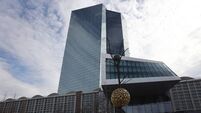David McNamara: Central banks push back against rate cuts

The European Central Bank in Frankfurt: The ECB was one of three central banks to push back against rate cuts.
Following January's decision of the European Central Bank last week, the US Federal Reserve and Bank of England announced their decisions on interest rates, with both opting to hold for now.
While it was widely expected monetary policy would remain on pause, central bank watchers were parsing the press conferences for subtle signs both central banks would move soon.
In the aftermath, markets had moved little, with investors having already digested incoming data and comments by key central bankers over the new year period, and adjusted rate expectations accordingly.
The expected pivot signalled by the Fed was in dropping its tightening bias by subtly changing the language in its statement. The market still expects a first US rate cut at its May meeting, followed by circa 140 basis points of cuts by year-end, which is considerably more aggressive than the current guidance.
However, these expectations could yet converge when the Fed publishes new economic forecasts after its next meeting on March 20, which take into account recent weaker inflation and labour market data.
For his part, Bank of England governor Andrew Bailey said the question for it to ponder was "no longer how restrictive monetary policy has to be, but how long do we need to keep policy restrictive".
Certainly, the new forecasts published by the Bank of England suggest its inflation expectations have tempered. Further good news in its new economic forecasts supports this theme.
However, with uncertainties on the horizon in the form of a potential giveaway UK budget in March and a change of government thereafter, the governor remained reticent to provide firmer guidance.
For now, the market is buying this reticence and is pricing in considerably less in rate cuts by the Bank of England, compared with the Fed or ECB, at 100 basis points by the year end.
On the currency markets over the past week the dollar lost some modest ground. The euro has traded towards the top end of its recent $1.07 to $1.09 range by last week, and sterling also gained ground versus the dollar, trading up towards $1.28.
Against sterling, the euro has remained range bound, trading about 85.5 pence.
Bond yields were lower for much of the previous week on the back of the news from the central banks, with significant movement for long-dated US treasuries driven by re-emerging strains in US regional banks that have exposures to commercial real estate market losses.
The fragilities in US commercial real estate may be an ongoing theme as the corporate earnings season unfolds in the coming weeks.
This week will be a good deal quieter, with central bank decisions in the rear view mirror. The key macro data points to watch are the final set of purchasing managers indices for January, which will provide a steer on the strength of the global economy in the early part of the year.
- David McNamara is chief economist at AIB











